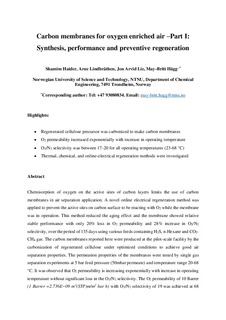| dc.contributor.author | Haider, Shamim | |
| dc.contributor.author | Lindbråthen, Arne | |
| dc.contributor.author | Lie, Jon Arvid | |
| dc.contributor.author | Hagg, May-Britt | |
| dc.date.accessioned | 2018-09-05T08:34:54Z | |
| dc.date.available | 2018-09-05T08:34:54Z | |
| dc.date.created | 2018-05-22T09:03:06Z | |
| dc.date.issued | 2018 | |
| dc.identifier.citation | Separation and Purification Technology. 2018, 204 290-297. | nb_NO |
| dc.identifier.issn | 1383-5866 | |
| dc.identifier.uri | http://hdl.handle.net/11250/2560846 | |
| dc.description.abstract | Chemisorption of oxygen on the active sites of carbon layers limits the use of carbon membranes in air separation application. A novel online electrical regeneration method was applied to prevent the active sites on carbon surface to be reacting with O2 while the membrane was in operation. This method reduced the aging effect and the membrane showed relative stable performance with only 20% loss in O2 permeability and 28% increase in O2/N2 selectivity, over the period of 135 days using various feeds containing H2S, n-Hexane and CO2-CH4 gas. The carbon membranes reported here were produced at the pilot-scale facility by the carbonization of regenerated cellulose under optimized conditions to achieve good air separation properties. The permeation properties of the membranes were tested by single gas separation experiments at 5 bar feed pressure (50 mbar permeate) and temperature range 20–68 °C. It was observed that O2 permeability is increasing exponentially with increase in operating temperature without significant loss in the O2/N2 selectivity. The O2 permeability of 10 Barrer (1 Barrer = 2.736E − 09 m3(STP)m/m2 bar h) with O2/N2 selectivity of 19 was achieved at 68 °C. Thermal (80 °C), chemical (propylene) and online-electrical (10 V DC) regeneration approaches were studied to lessen the aging effect on carbon membranes. | nb_NO |
| dc.language.iso | eng | nb_NO |
| dc.publisher | Elsevier | nb_NO |
| dc.rights | Attribution-NonCommercial-NoDerivatives 4.0 Internasjonal | * |
| dc.rights.uri | http://creativecommons.org/licenses/by-nc-nd/4.0/deed.no | * |
| dc.title | Carbon membranes for oxygen enriched air – Part I: Synthesis, performance and preventive regeneration | nb_NO |
| dc.type | Journal article | nb_NO |
| dc.type | Peer reviewed | nb_NO |
| dc.description.version | acceptedVersion | nb_NO |
| dc.source.pagenumber | 290-297 | nb_NO |
| dc.source.volume | 204 | nb_NO |
| dc.source.journal | Separation and Purification Technology | nb_NO |
| dc.identifier.doi | https://doi.org/10.1016/j.seppur.2018.05.014 | |
| dc.identifier.cristin | 1585801 | |
| dc.description.localcode | © 2018. This is the authors’ accepted and refereed manuscript to the article. Locked until 8.5.2020 due to copyright restrictions. This manuscript version is made available under the CC-BY-NC-ND 4.0 license http://creativecommons.org/licenses/by-nc-nd/4.0/ | nb_NO |
| cristin.unitcode | 194,66,30,0 | |
| cristin.unitname | Institutt for kjemisk prosessteknologi | |
| cristin.ispublished | true | |
| cristin.fulltext | postprint | |
| cristin.qualitycode | 1 | |

